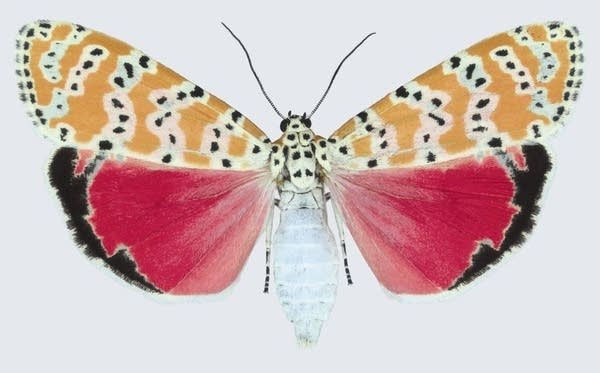Capturing dark beauties on paper
Go Deeper.
Create an account or log in to save stories.
Like this?
Thanks for liking this story! We have added it to a list of your favorite stories.

About 10 years ago in eastern New York, Alfred University's Institute for Electronic Arts purchased a high resolution scanner. After installing the device, Institute co-founder Joseph Scheer and other faculty needed to test it.
Scheer looked around his office.

"So there's this tiny little gnat flying around," he explains. "A gnat was something I would never pay any attention to. It's something you dismiss. So as a joke I grabbed it in my hand and put it under the scanner and closed the lid. And when the image came out, I was just knocked out. It was so beautiful."
Alfred is an isolated rural town. Scheer would come into the art building in the morning and find dead moths on the floors and windowsills of the building. He kept them in a dish on his desk.
Turn Up Your Support
MPR News helps you turn down the noise and build shared understanding. Turn up your support for this public resource and keep trusted journalism accessible to all.
After the gnat turned out so brilliantly, he knew exactly what to do with the moths. He recreates them on watercolor paper three feet by four feet. He started with the moths in eastern New York state. Now Scheer scans moths from across the globe.
Yet to say he scans them oversimplifies the art and craft. Scheer makes 20 or so high-definition scans at varying depths. He matches those images together bit by bit to create the most vibrant, meticulous rendering of the moth.

At the Hilstrom, Scheer walks over to a green and gray moth hanging in the exhibit. It's from the Tortricid family, and normally its wings span less than half an inch. But here the body and wings are blown up so that each hair and scale is revealed.
"It's just amazing. The size of the scales across its wing change shape and size. There are tufts on them. Some of them are like hearing devices on some species. Some of them emit pheromone there," he says. "Then there's this beautiful green. And the green there's probably across this wing there are probably 100 shades of green from celydons to turquoises to olives to teals."
Moths are night fliers sharing the same ancestors as butterflies. Their flight is musical in a way. Literally they emit a sound while they fly. Figuratively, their movement can be graceful or chaotic.

Enthusiasts have documented over 150 thousand species of moths. Scientists believe another 90 thousand species exist. Scheer guesses he's documented tens of thousands of them.
You could think of his work as nature paintings, and Scheer does enjoy teaching people about the lives of moths. He considers the work a biodiversity project with deep symbolism. Moths are drawn to light, and that prompts Scheer to think of Greek mythology and Icarus, another character who flew to the light, Scheer says in pursuit of knowledge.
Scheer also thinks of the light people say they see just before death. Their nocturnal life has often been associated with witchcraft. He likens it to the exuberance and sexuality of human night life.

"Also I think of them as the punk rockers of the insect world because of their color combinations," he says. "You have this one around the corner. You have kind of zebra striped, with tiger stripes with this wonderful red and black brocade. Now a butterfly would never do that. But that's something just really rich and loaded."
Another has spots like a cow on its top wings. Its bottom wings are orange with metallic blue leopard spots and red fringe. It's startlingly attractive. That beauty reaches the core of Scheer's interest in moths.
"Why was I never told moths were beautiful in my education? I always say who's in charge of misunderstanding? Who's in charge of beauty? If someone is considered beautiful they have an easier go in life. We think of butterflies as beautiful, but who made that decision?"
The question may sound esoteric to some, but Scheer puts it in real terms. No one documents moths. They're more likely to be squashed or shrieked at. Scheer says the same is true for people. So at the Hilstrom 25 moths are on display. He doesn't play favorites. He doesn't use pet names. He just shows them in their pure beauty.




